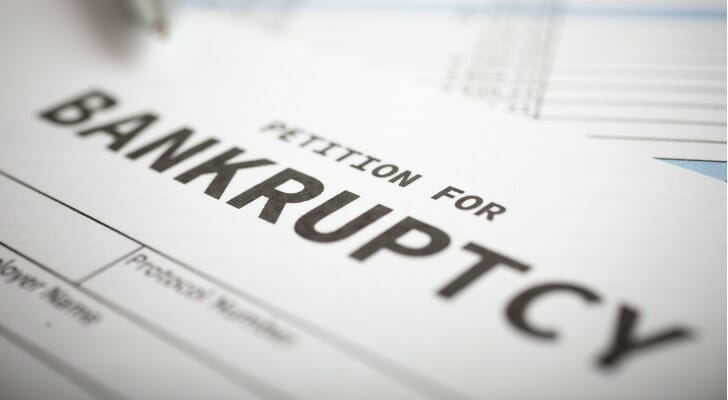If your small business is struggling to pay its debts and your creditors are threatening to take your assets, bankruptcy is an option. Although bankruptcy sounds like the end, it actually can be a way for a business in dire straits to find a new beginning. With the right understanding of bankruptcy, a small business owner can repair a troubled balance sheet and keep his or her business going. Here’s how to declare, what the process looks like and how your company can survive it.
The Bankruptcy Process
To seek bankruptcy, a business owner files a petition with the bankruptcy court. It’s not required to hire an attorney to do this and individual business owners can do the paperwork themselves in less complicated cases.
A bankruptcy filing forces creditors to stop trying to collect debts or take over your business. It lets business owners keep the property they need to run the business, provides time to raise money by selling assets and gives them leverage to negotiate modified payment terms on secured loans for real estate, equipment or similar property. In some cases, bankruptcy can erase debts that the business is not able to pay.
After filing the petition, in most cases the owner will devise a plan to repay creditors, often with longer terms or lower payment amounts. The plan is presented to the bankruptcy court for approval. If it’s approved, the business will pay off creditors in the agreed manner. That may be by continuing operations and making payments or by liquidating the company’s assets and turning proceeds over to creditors.
Preparing to File
Sometimes creditors can force a business to seek protection. Other times it’s the owner’s decision. When a business owner reaches the point that filing a petition for protection with a bankruptcy court is a consideration, there are three questions to ask.
The first question is about the plans for the business. If a business owner does not plan to continue operations, that will suggest one strategy. If the business owner does hope to stay in business, that suggests another.
The next question is whether the business owner has personally guaranteed any of the business debts. This, again, will affect how the business approaches bankruptcy. Sometimes, the business owner may decide to file for personal bankruptcy as well, although this is not always the case.
Finally, how is the business structured? Whether a business is a sole proprietorship, partnership, limited liability company or corporation will determine the options that are available.
Three Kinds of Bankruptcy
 Armed with these answers, a business is prepared to decide how to file. There are three different ways to file for bankruptcy: Chapter 7, Chapter 11 and Chapter 13. Here are the distinctive features of each.
Armed with these answers, a business is prepared to decide how to file. There are three different ways to file for bankruptcy: Chapter 7, Chapter 11 and Chapter 13. Here are the distinctive features of each.
- Chapter 7 – When a partnership, LLC or corporation is not going to continue, this is often the type of bankruptcy chosen. Instead, the business will wind up operations and a trustee appointed by the bankruptcy court will sell the business assets and turn the proceeds over to the creditors. This will discharge any unsecured debts, meaning the creditor can no long try to collect them.
- Chapter 11 – Known as “reorganization bankruptcy,” this often time-consuming and expensive option is used by large businesses that want to keep operating while they restructure their debts and assets. However, twice in recent months terms of Chapter 11 filings have become significantly more small business-friendly. Since Feb. 19, 2020, when a law Congress passed last year took effect, it has become far less expensive and time-consuming, and it has increased the likelihood of filers retaining ownership of their businesses. Then, in March, Congress included in the CARES Act a temporary provision, which expires March 27, 2021, that expanded eligibility to use this option by raising the debt limit of filers to $7.5 million from $2.73 million.
- Chapter 13 – This is the one most small businesses have been choosing. Chapter 13 is simpler and less expensive than Chapter 11. A Chapter 13 filing is also suitable for a business owner who plans to continue the business. However, Chapter 13 is only available to sole proprietors. Partnerships, limited liability companies and corporations can’t go this way.
However, if the business owner has personally guaranteed any of the business debt, the creditor may still try to collect from the owner. With a Chapter 7 bankruptcy, the owner may lose personal assets to the business’s creditors, up to and including the owner’s personal home.
Surviving Bankruptcy

If a business owner selects any option but Chapter 7, which will erase secured business debts, and wants to reorganize and continue operations, the owner has to be able to present a convincing plan to the bankruptcy court for how the business will generate enough revenue to pay creditors. It is up to the court whether or not to approve the plan the business owner has presented. But if it is approved, the creditors have to respect it.
Bankruptcy is not the only way to end a business. If a business owner can pay off all debts, he or she can simply settle with creditors and close the doors without filing for bankruptcy.
The Bottom Line
Bankruptcy is a useful and widely used tool for businesses in trouble to get breathing room and protection from creditors while they raise money and renegotiate payment terms. It can presage the end of a business. But in many cases businesses are able to continue operations afterward and even obtain new financing to return to a growth track.
Tips for Handling a Business Bankruptcy
- Small business owners have unique financial planning needs, and many financial advisors specialize in working with business owners. Finding the right financial advisor who fits your needs doesn’t have to be hard. SmartAsset’s free tool matches you with financial advisors in your area in five minutes. If you’re ready to be matched with local advisors who will help you achieve your financial goals, get started now.
- Filing for bankruptcy protection might save your home, but it will inflict significant damage to your credit score. You can expect your score to drop by 100 points or more after you file a Chapter 13 or Chapter 7 bankruptcy.
Photo credit: ©iStock.com/Dan Rentea, ©iStock.com/Minerva Studio, ©iStock.com/hidesy
